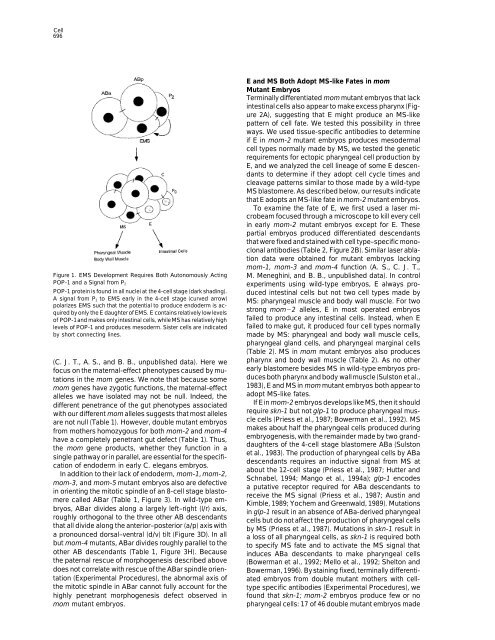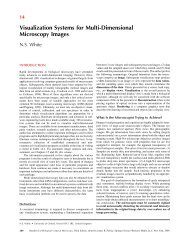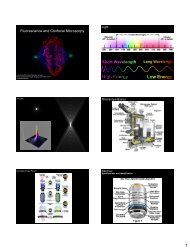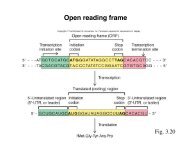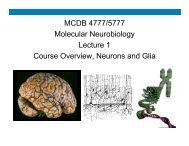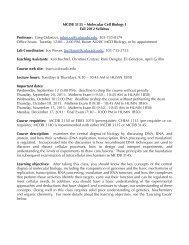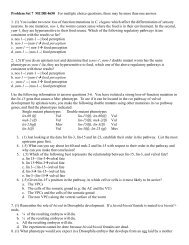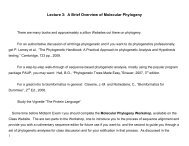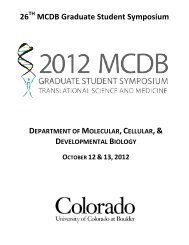Wnt Signaling Polarizes an Early C. elegans ... - MCD Biology
Wnt Signaling Polarizes an Early C. elegans ... - MCD Biology
Wnt Signaling Polarizes an Early C. elegans ... - MCD Biology
Create successful ePaper yourself
Turn your PDF publications into a flip-book with our unique Google optimized e-Paper software.
Cell<br />
696<br />
E <strong>an</strong>d MS Both Adopt MS-like Fates in mom<br />
Mut<strong>an</strong>t Embryos<br />
Terminally differentiated mom mut<strong>an</strong>t embryos that lack<br />
intestinal cells also appear to make excess pharynx (Figure<br />
2A), suggesting that E might produce <strong>an</strong> MS-like<br />
pattern of cell fate. We tested this possibility in three<br />
ways. We used tissue-specific <strong>an</strong>tibodies to determine<br />
if E in mom-2 mut<strong>an</strong>t embryos produces mesodermal<br />
cell types normally made by MS, we tested the genetic<br />
requirements for ectopic pharyngeal cell production by<br />
E, <strong>an</strong>d we <strong>an</strong>alyzed the cell lineage of some E descend<strong>an</strong>ts<br />
to determine if they adopt cell cycle times <strong>an</strong>d<br />
cleavage patterns similar to those made by a wild-type<br />
MS blastomere. As described below, our results indicate<br />
that E adopts <strong>an</strong> MS-like fate in mom-2 mut<strong>an</strong>t embryos.<br />
To examine the fate of E, we first used a laser microbeam<br />
focused through a microscope to kill every cell<br />
in early mom-2 mut<strong>an</strong>t embryos except for E. These<br />
partial embryos produced differentiated descend<strong>an</strong>ts<br />
that were fixed <strong>an</strong>d stained with cell type–specific monoclonal<br />
<strong>an</strong>tibodies (Table 2, Figure 2B). Similar laser ablation<br />
data were obtained for mut<strong>an</strong>t embryos lacking<br />
mom-1, mom-3 <strong>an</strong>d mom-4 function (A. S., C. J. T.,<br />
Figure 1. EMS Development Requires Both Autonomously Acting M. Meneghini, <strong>an</strong>d B. B., unpublished data). In control<br />
POP-1 <strong>an</strong>d a Signal from P2 experiments using wild-type embryos, E always pro-<br />
POP-1 protein is found in all nuclei at the 4-cell stage (dark shading). duced intestinal cells but not two cell types made by<br />
A signal from P2 to EMS early in the 4-cell stage (curved arrow)<br />
MS: pharyngeal muscle <strong>an</strong>d body wall muscle. For two<br />
polarizes EMS such that the potential to produce endoderm is acstrong<br />
mom2 alleles, E in most operated embryos<br />
quired by only the E daughter of EMS. E contains relatively low levels<br />
of POP-1<strong>an</strong>d makes only intestinal cells, whileMS has relativelyhigh failed to produce <strong>an</strong>y intestinal cells. Instead, when E<br />
levels of POP-1 <strong>an</strong>d produces mesoderm. Sister cells are indicated failed to make gut, it produced four cell types normally<br />
by short connecting lines. made by MS: pharyngeal <strong>an</strong>d body wall muscle cells,<br />
pharyngeal gl<strong>an</strong>d cells, <strong>an</strong>d pharyngeal marginal cells<br />
(Table 2). MS in mom mut<strong>an</strong>t embryos also produces<br />
(C. J. T., A. S., <strong>an</strong>d B. B., unpublished data). Here we pharynx <strong>an</strong>d body wall muscle (Table 2). As no other<br />
focus on the maternal-effect phenotypes caused by mu- early blastomere besides MS in wild-type embryos pro-<br />
tations in the mom genes. We note that because some duces both pharynx <strong>an</strong>d body wall muscle (Sulston et al.,<br />
mom genes have zygotic functions, the maternal-effect 1983), E <strong>an</strong>d MS in mom mut<strong>an</strong>t embryos both appear to<br />
alleles we have isolated may not be null. Indeed, the adopt MS-like fates.<br />
different penetr<strong>an</strong>ce of the gut phenotypes associated<br />
If E in mom-2 embryos develops like MS, then it should<br />
with our different mom alleles suggests that most alleles<br />
require skn-1 but not glp-1 to produce pharyngeal mus-<br />
are not null (Table 1). However, double mut<strong>an</strong>t embryos<br />
cle cells (Priess et al., 1987; Bowerm<strong>an</strong> et al., 1992). MS<br />
from mothers homozygous for both mom-2 <strong>an</strong>d mom-4<br />
makes about half the pharyngeal cells produced during<br />
have a completely penetr<strong>an</strong>t gut defect (Table 1). Thus,<br />
embryogenesis, with the remainder made by two gr<strong>an</strong>d-<br />
daughters of the 4-cell stage blastomere ABa (Sulston<br />
the mom gene products, whether they function in a<br />
et al., 1983). The production of pharyngeal cells by ABa<br />
single pathway or in parallel, are essential for the specifidescend<strong>an</strong>ts<br />
requires <strong>an</strong> inductive signal from MS at<br />
cation of endoderm in early C. eleg<strong>an</strong>s embryos.<br />
about the 12-cell stage (Priess et al., 1987; Hutter <strong>an</strong>d<br />
In addition to their lack of endoderm, mom-1, mom-2,<br />
Schnabel, 1994; M<strong>an</strong>go et al., 1994a); glp-1 encodes<br />
mom-3, <strong>an</strong>d mom-5 mut<strong>an</strong>t embryos also are defective<br />
a putative receptor required for ABa descend<strong>an</strong>ts to<br />
in orienting the mitotic spindle of <strong>an</strong> 8-cell stage blastoreceive<br />
the MS signal (Priess et al., 1987; Austin <strong>an</strong>d<br />
mere called ABar (Table 1, Figure 3). In wild-type em-<br />
Kimble, 1989; Yochem <strong>an</strong>d Greenwald, 1989). Mutations<br />
bryos, ABar divides along a largely left–right (l/r) axis,<br />
in glp-1 result in <strong>an</strong> absence of ABa-derived pharyngeal<br />
roughly orthogonal to the three other AB descend<strong>an</strong>ts<br />
cells but do not affect the production of pharyngeal cells<br />
that all divide along the <strong>an</strong>terior–posterior (a/p) axis with<br />
by MS (Priess et al., 1987). Mutations in skn-1 result in<br />
a pronounced dorsal–ventral (d/v) tilt (Figure 3D). In all a loss of all pharyngeal cells, as skn-1 is required both<br />
but mom-4 mut<strong>an</strong>ts, ABar divides roughly parallel to the to specify MS fate <strong>an</strong>d to activate the MS signal that<br />
other AB descend<strong>an</strong>ts (Table 1, Figure 3H). Because induces ABa descend<strong>an</strong>ts to make pharyngeal cells<br />
the paternal rescue of morphogenesis described above (Bowerm<strong>an</strong> et al., 1992; Mello et al., 1992; Shelton <strong>an</strong>d<br />
does not correlate with rescue of the ABar spindle orien- Bowerm<strong>an</strong>, 1996). By staining fixed,terminally differentitation<br />
(Experimental Procedures), the abnormal axis of ated embryos from double mut<strong>an</strong>t mothers with cellthe<br />
mitotic spindle in ABar c<strong>an</strong>not fully account for the type specific <strong>an</strong>tibodies (Experimental Procedures), we<br />
highly penetr<strong>an</strong>t morphogenesis defect observed in found that skn-1; mom-2 embryos produce few or no<br />
mom mut<strong>an</strong>t embryos.<br />
pharyngeal cells: 17 of 46 double mut<strong>an</strong>t embryos made


